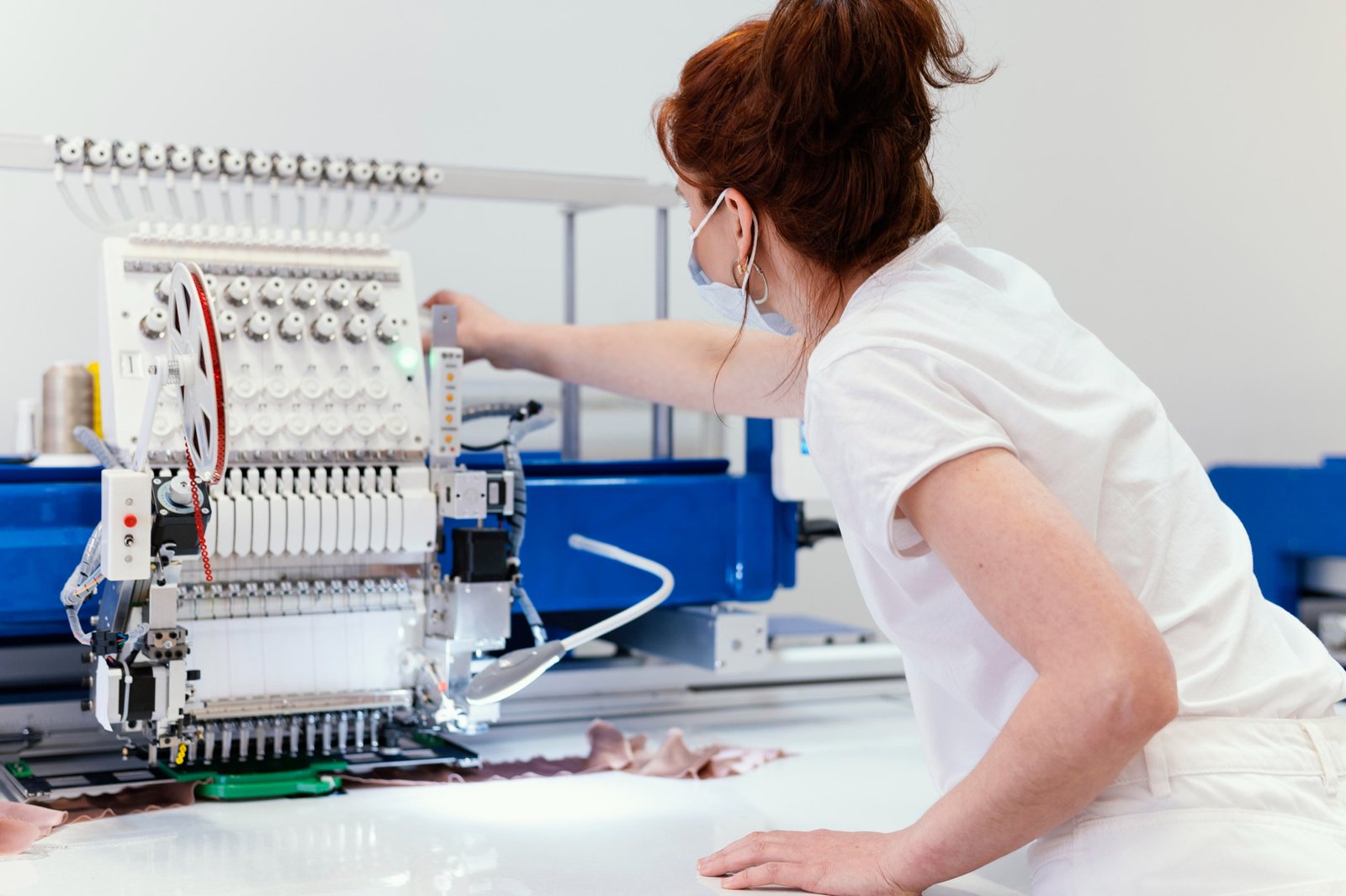The global textile industry is entering a new era, where innovation is no longer limited to machinery and raw materials but is increasingly driven by data and intelligence. AI in textile manufacturing is emerging as a game changer, helping companies overcome long-standing challenges such as high production costs, inconsistent quality, and unsustainable resource use. By applying artificial intelligence in textiles, manufacturers can transform how fabrics are designed, produced, and inspected.
Through AI-powered textile manufacturing, companies can optimize processes, predict issues before they occur, and accelerate the development of smart fabrics with advanced features. This shift is not only improving efficiency but also reducing waste, energy use, and environmental impact. As the market demands faster, cleaner, and more adaptive solutions, AI in textile manufacturing is positioning itself at the center of the industry’s sustainable and technological transformation.
In this article, we will explore what AI in textile manufacturing really means, the challenges it helps solve, its key applications across the industry, and the future of smart fabrics. By the end, you’ll understand how AI is redefining textiles and why it is essential for building a more innovative and sustainable industry.
1. What Does AI in Textile Manufacturing Mean?
AI in textile manufacturing refers to the use of advanced algorithms, computer vision, and machine learning to optimize how textiles are designed, produced, and inspected. Unlike traditional automation, which simply executes repetitive tasks, artificial intelligence brings adaptability and decision-making to the factory floor. For example, AI systems can recognize fabric types in real time, adjust machine settings automatically, and detect subtle defects invisible to the human eye. These intelligent textile systems go beyond efficiency: they help create higher-quality fabrics, minimize energy and water usage, and support the production of eco-friendly and smart fabrics. With global supply chains under pressure to deliver more sustainable and cost-effective outcomes, AI empowers manufacturers to meet consumer expectations while aligning with international standards. In short, AI in textiles is not just about automation—it’s about transforming the entire industry into a more innovative, data-driven, and sustainable ecosystem.
2. Current Challenges in Textile Manufacturing
Despite being one of the world’s largest industries, textile manufacturing faces persistent challenges that hinder efficiency and sustainability. Conventional processes often result in inconsistent quality due to manual inspections, leading to product defects and high return rates. Additionally, resource intensity is a major concern: traditional dyeing and finishing consume massive amounts of water, energy, and chemicals, creating pollution and raising operational costs. Another challenge is the reliance on manual labor for tasks like fabric inspection, which is time-consuming, error-prone, and expensive. Supply chain disruptions further complicate operations, especially when manufacturers depend heavily on fossil-based fibers such as polyester. Finally, waste management remains a critical issue, with millions of tons of discarded textiles ending up in landfills every year. These challenges underline the urgency for innovation. By adopting AI in textile manufacturing, companies can automate quality control, optimize resource consumption, and create smart, sustainable fabrics, addressing industry pain points while preparing for a greener and more efficient future.
3. Key Applications of AI in Textile Manufacturing
Artificial intelligence is no longer an abstract concept in the textile sector—it is a practical tool driving innovation and efficiency. Below are four major applications of AI in textile manufacturing that are reshaping production processes and enabling smarter, more sustainable outcomes.
3.1. Fabric Recognition & Classification
One of the most powerful uses of AI in textile manufacturing is fabric recognition. By applying computer vision and machine learning, AI systems can instantly identify fabric types, patterns, and textures. This capability allows factories to automate classification, reducing human error and accelerating workflow. For example, AI can distinguish between cotton, polyester, or blended fabrics in real time, ensuring that the right treatment processes are applied. This not only improves production accuracy but also enables smart inventory management, making the supply chain more transparent and responsive to customer needs.
3.2. Defect Detection & Quality Control
Quality assurance has traditionally been labor-intensive and prone to human error. With AI-powered defect detection, manufacturers can inspect fabrics in real time and identify flaws such as misweaves, holes, stains, or irregular dyeing. High-resolution imaging combined with deep learning algorithms ensures even the smallest defects are caught before products leave the factory. This not only reduces waste but also minimizes costly returns and enhances customer satisfaction. By embedding AI into quality control, textile producers can achieve higher levels of consistency and reliability while freeing workers from repetitive and error-prone inspection tasks.
3.3. Process Optimization & Energy Efficiency
Another key benefit of AI in textile manufacturing is the ability to optimize production processes. AI systems continuously monitor machine operations, adjusting parameters such as speed, temperature, and chemical dosage. This dynamic control reduces unnecessary energy and water consumption, directly lowering operational costs and environmental impact. For example, AI can fine-tune dyeing processes to minimize water use or optimize cutting layouts to reduce fabric waste. By improving both resource efficiency and productivity, AI enables manufacturers to meet sustainability targets while delivering products faster and at a higher quality.
3.4. Predictive Maintenance
Unplanned machine downtime is one of the biggest cost drivers in textile manufacturing. Through predictive maintenance, AI uses sensors and data analytics to monitor equipment health in real time. Algorithms can detect early signs of wear, vibration anomalies, or overheating, predicting failures before they occur. This proactive approach reduces downtime, extends machine lifespan, and prevents costly interruptions in production. Predictive maintenance also improves workplace safety by ensuring machines are operating under optimal conditions. For textile manufacturers aiming to maximize efficiency, AI-driven predictive maintenance is becoming a critical tool to ensure continuous, reliable operations.
4. Smart Fabrics: Where AI Meets Innovation
The rise of smart fabrics demonstrates how AI in textile manufacturing is expanding beyond process optimization to product innovation. Smart fabrics are textiles embedded with sensors, actuators, or adaptive properties that respond to external stimuli such as heat, light, or motion. AI plays a crucial role in designing, analyzing, and improving these materials. For instance, AI algorithms help optimize how conductive fibers are woven, enabling fabrics to monitor body temperature, detect motion, or even change color in response to light.
Applications are wide-ranging. In sportswear, smart fabrics can track performance metrics like heart rate or hydration. In healthcare, AI-enabled textiles are being developed to monitor patients’ vital signs, supporting early diagnosis and personalized care. The fashion industry is exploring fabrics that change color or texture on demand, offering a new dimension of creativity and personalization. In the military, AI-powered textiles provide adaptive camouflage or temperature regulation to enhance soldier performance.
By integrating AI with material science, smart fabrics are pushing the boundaries of what textiles can do. They represent not just an incremental improvement, but a paradigm shift toward interactive, multifunctional, and sustainable fabrics that align with the needs of a technology-driven future.

5. Benefits of AI in Textile Manufacturing
The adoption of AI in textile manufacturing delivers benefits that extend across operations, products, and markets. One of the most immediate advantages is improved quality and reduced waste. Automated defect detection ensures fabrics meet higher standards, reducing rework and lowering landfill contributions.
Another key benefit is greater efficiency and cost savings. By optimizing machine parameters and resource use, AI minimizes water, energy, and chemical consumption—directly lowering operational costs while supporting sustainability goals. This efficiency also accelerates production cycles, enabling faster time-to-market.
AI also supports compliance with global standards such as ISO and OEKO-TEX®, helping manufacturers meet regulatory requirements and expand access to international markets. Beyond compliance, AI strengthens brand reputation by demonstrating a commitment to innovation and eco-conscious practices, making companies more attractive to eco-aware consumers and investors.
Finally, AI accelerates innovation in textiles. From smart fabrics to predictive maintenance, AI reduces development cycles and enables companies to bring new solutions to market quickly. Together, these benefits make AI not just a technological upgrade but a strategic enabler, positioning textile manufacturers for growth, resilience, and leadership in an increasingly competitive and sustainable global industry.
6. Case Studies and Industry Examples
Real-world examples highlight the transformative potential of AI in textile manufacturing. Leading brands and manufacturers are already integrating AI into their production lines with measurable results. For instance, several Asian textile mills using AI-powered defect detection have reported up to a 30% reduction in fabric waste and faster quality control cycles. European fashion brands are leveraging AI-driven fabric recognition and process optimization to improve dyeing consistency, resulting in 20% better quality outcomes and reduced water consumption. In the U.S., sportswear companies are experimenting with AI-enabled predictive maintenance to cut machine downtime by nearly 25%, ensuring continuous production and higher throughput. These case studies demonstrate that AI is not only about futuristic promises but about delivering immediate operational efficiency, sustainability gains, and competitive advantages. The evidence is clear: manufacturers who adopt AI today are positioning themselves as leaders in tomorrow’s textile industry.
7. Future Outlook: AI and the Next Era of Textiles
The future of AI in textile manufacturing extends far beyond factory floors. As AI integrates with IoT and Big Data, textile supply chains are becoming smarter, more transparent, and predictive. Connected sensors and analytics will allow real-time monitoring of resource use, from water and energy to chemical inputs, creating the foundation for zero-waste manufacturing. At the same time, AI will accelerate the growth of smart fabrics, combining adaptive features with innovations in biotechnology—such as bio-based fibers that are both sustainable and intelligent. Imagine fabrics that self-regulate temperature, heal minor damage, or track vital signs seamlessly. These breakthroughs will redefine performance in industries from healthcare to fashion and defense. Ultimately, AI is not just optimizing today’s textile processes—it is shaping a new era where textiles become interactive, sustainable, and deeply embedded in the digital ecosystem. The next chapter of textiles will be written with algorithms and innovation working side by side.
Conclusion
AI in textile manufacturing is no longer an optional upgrade—it is the inevitable future of the industry. By improving quality, reducing waste, and enabling the rise of smart fabrics, AI is transforming textiles into a more sustainable and data-driven ecosystem. This shift empowers manufacturers to stay competitive while meeting the demands of eco-conscious consumers and global markets. Fabrizon is ready to deliver AI-driven solutions that turn sustainability goals into business advantages. Contact us today to begin building the future of smart, sustainable textiles.

